大学英语中修辞手法归纳总结
- 格式:doc
- 大小:61.49 KB
- 文档页数:21
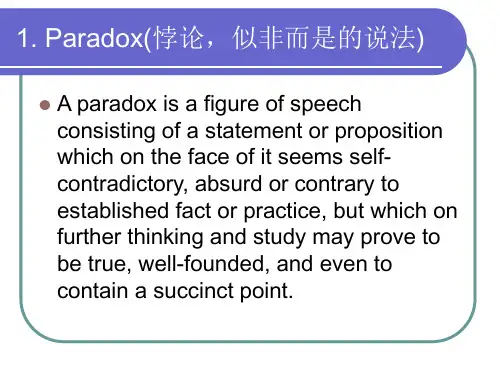
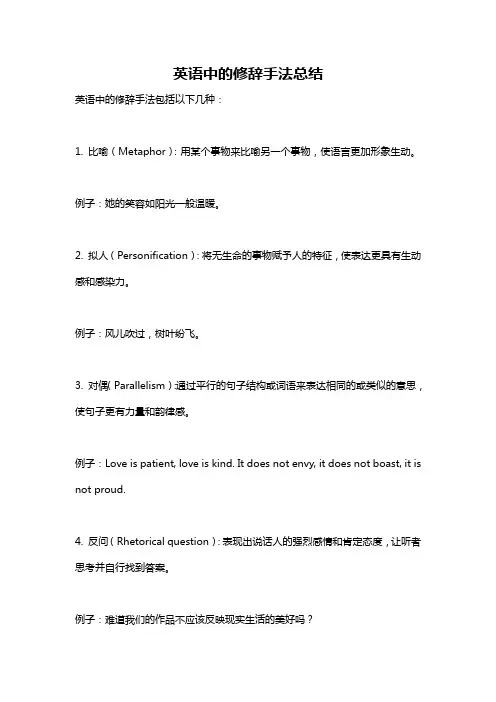
英语中的修辞手法总结
英语中的修辞手法包括以下几种:
1. 比喻(Metaphor):用某个事物来比喻另一个事物,使语言更加形象生动。
例子:她的笑容如阳光一般温暖。
2. 拟人(Personification):将无生命的事物赋予人的特征,使表达更具有生动感和感染力。
例子:风儿吹过,树叶纷飞。
3. 对偶(Parallelism):通过平行的句子结构或词语来表达相同的或类似的意思,使句子更有力量和韵律感。
例子:Love is patient, love is kind. It does not envy, it does not boast, it is not proud.
4. 反问(Rhetorical question):表现出说话人的强烈感情和肯定态度,让听者思考并自行找到答案。
例子:难道我们的作品不应该反映现实生活的美好吗?
5. 比较(Comparison):通过将两个不同的事物进行类比,使得听者或读者更容易理解某个观点。
例子:她跑得像一只兔子一样快。
以上是英语中常见的五种修辞手法,当然还有其他一些较少使用的修辞手法,如反语、夸张、卡里加里(Cacophony)等。
这些修辞手法都可以让语言更生动、更有表现力。
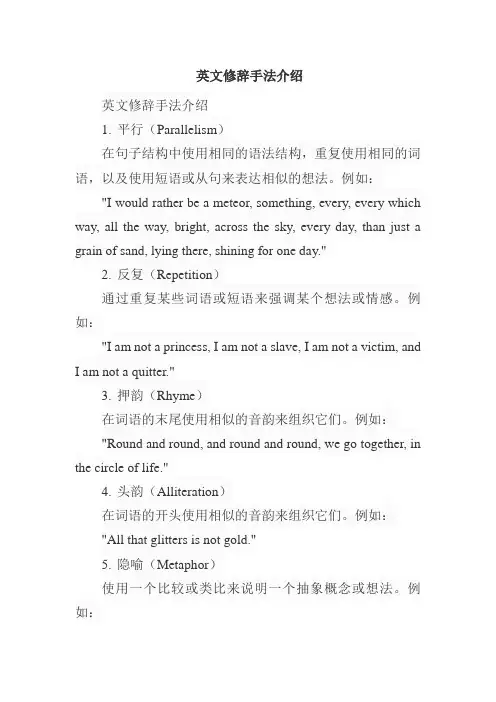
英文修辞手法介绍英文修辞手法介绍1. 平行(Parallelism)在句子结构中使用相同的语法结构,重复使用相同的词语,以及使用短语或从句来表达相似的想法。
例如:"I would rather be a meteor, something, every, every which way, all the way, bright, across the sky, every day, than just a grain of sand, lying there, shining for one day."2. 反复(Repetition)通过重复某些词语或短语来强调某个想法或情感。
例如:"I am not a princess, I am not a slave, I am not a victim, andI am not a quitter."3. 押韵(Rhyme)在词语的末尾使用相似的音韵来组织它们。
例如:"Round and round, and round and round, we go together, in the circle of life."4. 头韵(Alliteration)在词语的开头使用相似的音韵来组织它们。
例如:"All that glitters is not gold."5. 隐喻(Metaphor)使用一个比较或类比来说明一个抽象概念或想法。
例如:"He is a lion in battle."6. 明喻(Simile)使用像“像”或“如同”这样的词语来比较两个不同的事物或概念。
例如:"She sings like a bird."7. 反问(Rhetorical question)使用一个问题来表达一个陈述或观点,而不是提出真正的问题。
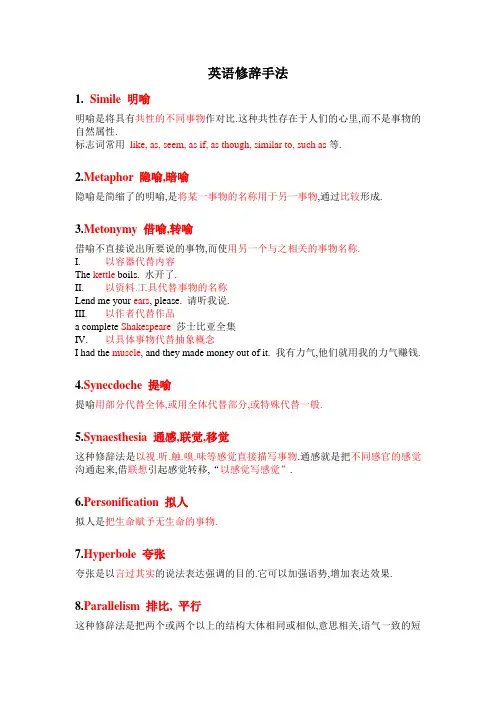
英语修辞手法1.Simile 明喻明喻是将具有共性的不同事物作对比.这种共性存在于人们的心里,而不是事物的自然属性.标志词常用like, as, seem, as if, as though, similar to, such as等.2.Metaphor 隐喻,暗喻隐喻是简缩了的明喻,是将某一事物的名称用于另一事物,通过比较形成.3.Metonymy 借喻,转喻借喻不直接说出所要说的事物,而使用另一个与之相关的事物名称.I.以容器代替内容The kettle boils. 水开了.II.以资料.工具代替事物的名称Lend me your ears, please. 请听我说.III.以作者代替作品a complete Shakespeare莎士比亚全集IV.以具体事物代替抽象概念I had the muscle, and they made money out of it. 我有力气,他们就用我的力气赚钱.4.Synecdoche 提喻提喻用部分代替全体,或用全体代替部分,或特殊代替一般.5.Synaesthesia 通感,联觉,移觉这种修辞法是以视.听.触.嗅.味等感觉直接描写事物.通感就是把不同感官的感觉沟通起来,借联想引起感觉转移,“以感觉写感觉”.6.Personification 拟人拟人是把生命赋予无生命的事物.7.Hyperbole 夸张夸张是以言过其实的说法表达强调的目的.它可以加强语势,增加表达效果.8.Parallelism 排比, 平行这种修辞法是把两个或两个以上的结构大体相同或相似,意思相关,语气一致的短语.句子排列成串,形成一个整体.9.Euphemism 委婉,婉辞法婉辞法指用委婉,文雅的方法表达粗恶,避讳的话.10.Allegory 讽喻,比方(原意“寓言”)建立在假借过去或别处的事例与对象之上,传达暗示,影射或者讥讽现世各种现象的含义.Make the hay while the sun shines.表层含义:趁着出太阳的时候晒草真正意味:趁热打铁11.Irony 反语反语指用相反意义的词来表达意思的作文方式.如在指责过失.错误时,用赞同过失的说法,而在表扬时,则近乎责难的说法.12.Pun 双关双关就是用一个词在句子中的双重含义,借题发挥.作出多种解释,旁敲侧击,从而达到意想不到的幽默.滑稽效果.它主要以相似的词形.词意和谐音的方式出现.If we don't hang together, we shall hang separately.13.Parody 仿拟这是一种模仿名言.警句.谚语,改动其中部分词语,从而使其产生新意的修辞. Rome was not built in a day, nor in a year.A friend in need is a friend to be avoided.14.Rhetorical question 修辞疑问(反问)它与疑问句的不同在于它并不以得到答复为目的,而是以疑问为手段,取得修辞上的效果,其特点是:肯定问句表示强烈否定,而否定问句表示强烈的肯定.它的答案往往是不言而喻的.15.Antithesis 对照,对比,对偶这种修辞指将意义完全相反的语句排在一起对比的一种修辞方法.Give me liberty, or give me death.16.Paradox 隽语这是一种貌似矛盾,但包含一定哲理的意味深长的说法,是一种矛盾修辞法.More haste, less speed.欲速则不达.17.Oxymoron 反意法,逆喻这也是一种矛盾修辞法,用两种不相调和的特征形容一个事物,以不协调的搭配使读者领悟句中微妙的含义.No light, but rather darkness visible.没有光亮,黑暗却清晰可见.18.Climax 渐进法,层进法这种修辞是将一系列词语按照意念的大小.轻重.深浅.高低等逐层渐进,最后达到顶点.可以增强语势,逐渐加深读者印象.19.Anticlimax 渐降法与climax相反的一种修辞法,将一系列词语由大到小,由强到弱地排列.20.Alliteration头韵法在文句中有两个以上连结在一起的词或词组,其开头的音节有同样的字母或声音,以增强语言的节奏感。
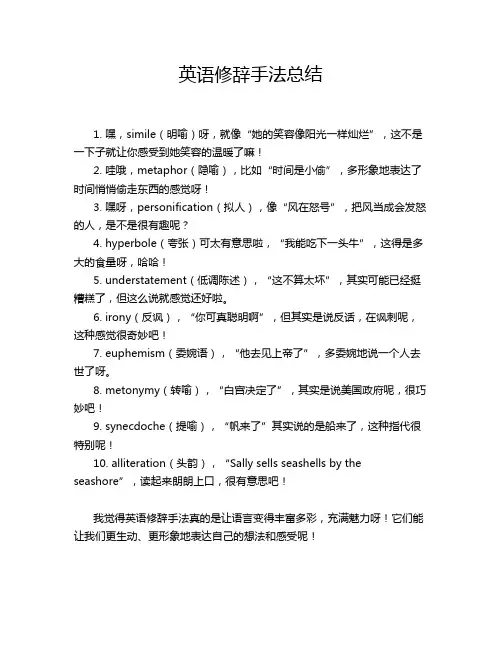
英语修辞手法总结
1. 嘿,simile(明喻)呀,就像“她的笑容像阳光一样灿烂”,这不是一下子就让你感受到她笑容的温暖了嘛!
2. 哇哦,metaphor(隐喻),比如“时间是小偷”,多形象地表达了时间悄悄偷走东西的感觉呀!
3. 嘿呀,personification(拟人),像“风在怒号”,把风当成会发怒的人,是不是很有趣呢?
4. hyperbole(夸张)可太有意思啦,“我能吃下一头牛”,这得是多大的食量呀,哈哈!
5. understatement(低调陈述),“这不算太坏”,其实可能已经挺糟糕了,但这么说就感觉还好啦。
6. irony(反讽),“你可真聪明啊”,但其实是说反话,在讽刺呢,这种感觉很奇妙吧!
7. euphemism(委婉语),“他去见上帝了”,多委婉地说一个人去世了呀。
8. metonymy(转喻),“白宫决定了”,其实是说美国政府呢,很巧妙吧!
9. synecdoche(提喻),“帆来了”其实说的是船来了,这种指代很特别呢!
10. alliteration(头韵),“Sally sells seashells by the seashore”,读起来朗朗上口,很有意思吧!
我觉得英语修辞手法真的是让语言变得丰富多彩,充满魅力呀!它们能让我们更生动、更形象地表达自己的想法和感受呢!。
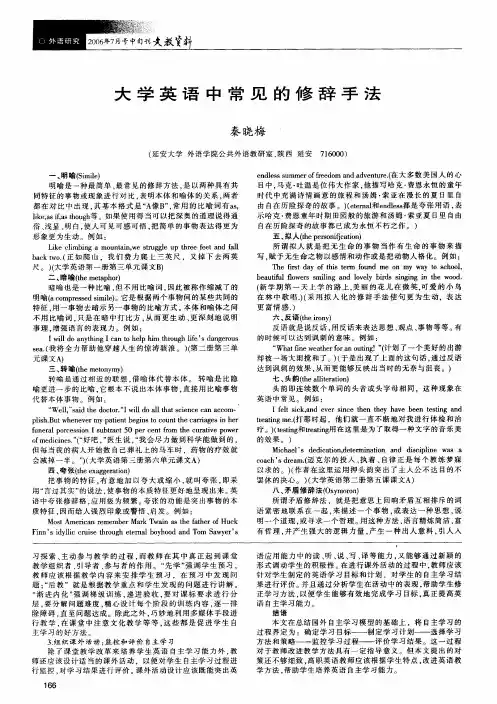
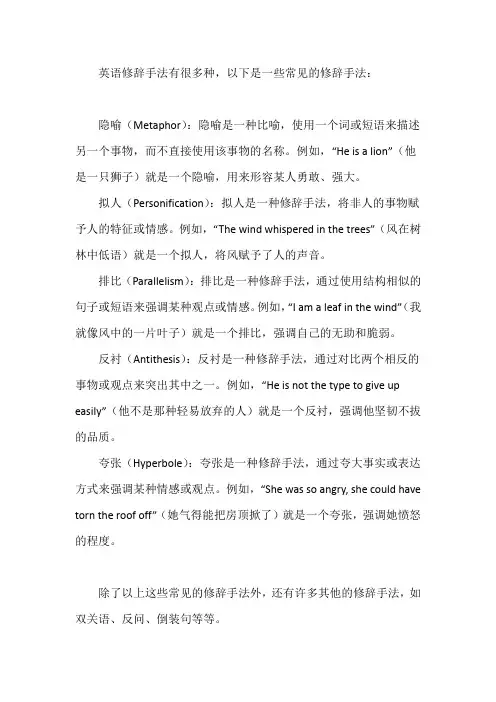
英语修辞手法有很多种,以下是一些常见的修辞手法:
隐喻(Metaphor):隐喻是一种比喻,使用一个词或短语来描述另一个事物,而不直接使用该事物的名称。
例如,“He is a lion”(他是一只狮子)就是一个隐喻,用来形容某人勇敢、强大。
拟人(Personification):拟人是一种修辞手法,将非人的事物赋予人的特征或情感。
例如,“The wind whispered in the trees”(风在树林中低语)就是一个拟人,将风赋予了人的声音。
排比(Parallelism):排比是一种修辞手法,通过使用结构相似的句子或短语来强调某种观点或情感。
例如,“I am a leaf in the wind”(我就像风中的一片叶子)就是一个排比,强调自己的无助和脆弱。
反衬(Antithesis):反衬是一种修辞手法,通过对比两个相反的事物或观点来突出其中之一。
例如,“He is not the type to give up easily”(他不是那种轻易放弃的人)就是一个反衬,强调他坚韧不拔的品质。
夸张(Hyperbole):夸张是一种修辞手法,通过夸大事实或表达方式来强调某种情感或观点。
例如,“S he was so angry, she could have torn the roof off”(她气得能把房顶掀了)就是一个夸张,强调她愤怒的程度。
除了以上这些常见的修辞手法外,还有许多其他的修辞手法,如双关语、反问、倒装句等等。
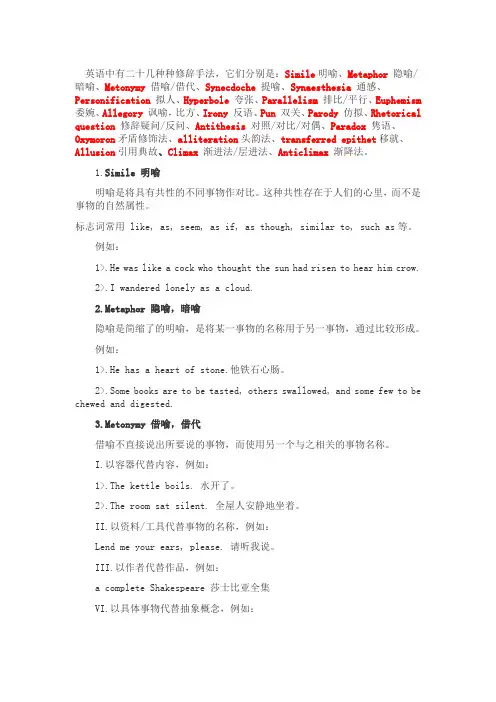
英语中有二十几种种修辞手法,它们分别是:Simile明喻、Metaphor隐喻/暗喻、Metonymy借喻/借代、Synecdoche提喻、Synaesthesia 通感、Personification拟人、Hyperbole夸张、Parallelism排比/平行、Euphemism 委婉、Allegory 讽喻,比方、Irony反语、Pun双关、Parody仿拟、Rhetorical question修辞疑问/反问、Antithesis对照/对比/对偶、Paradox隽语、Oxymoron矛盾修饰法、alliteration头韵法、transferred epithet移就、Allusion引用典故、Climax渐进法/层进法、Anticlimax渐降法。
1.Simile 明喻明喻是将具有共性的不同事物作对比。
这种共性存在于人们的心里,而不是事物的自然属性。
标志词常用 like, as, seem, as if, as though, similar to, such as等。
例如:1>.He was like a cock who thought the sun had risen to hear him crow.2>.I wandered lonely as a cloud.2.Metaphor 隐喻,暗喻隐喻是简缩了的明喻,是将某一事物的名称用于另一事物,通过比较形成。
例如:1>.He has a heart of stone.他铁石心肠。
2>.Some books are to be tasted, others swallowed, and some few to be chewed and digested.3.Metonymy 借喻,借代借喻不直接说出所要说的事物,而使用另一个与之相关的事物名称。
I.以容器代替内容,例如:1>.The kettle boils. 水开了。
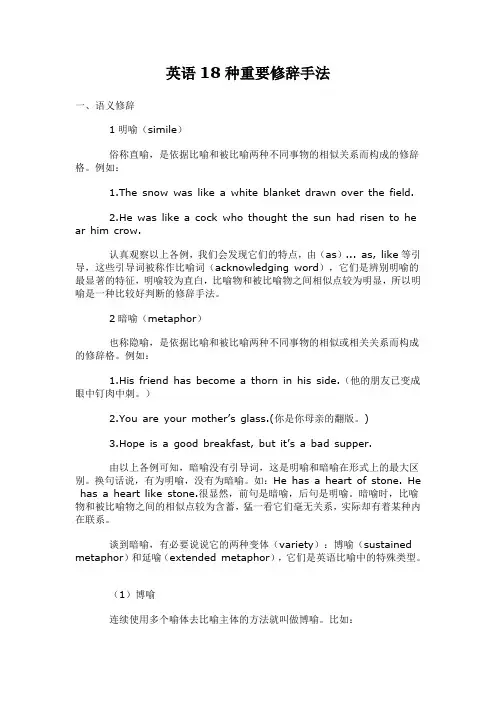
英语18种重要修辞手法一、语义修辞1明喻(simile)俗称直喻,是依据比喻和被比喻两种不同事物的相似关系而构成的修辞格。
例如:1.The snow was like a white blanket drawn over the field.2.He was like a cock who thought the sun had risen to he ar him crow.认真观察以上各例,我们会发现它们的特点,由(as)... as, like等引导,这些引导词被称作比喻词(acknowledging word),它们是辨别明喻的最显著的特征,明喻较为直白,比喻物和被比喻物之间相似点较为明显,所以明喻是一种比较好判断的修辞手法。
2暗喻(metaphor)也称隐喻,是依据比喻和被比喻两种不同事物的相似或相关关系而构成的修辞格。
例如:1.His friend has become a thorn in his side.(他的朋友已变成眼中钉肉中刺。
)2.You are your mother’s glass.(你是你母亲的翻版。
)3.Hope is a good breakfast, but it’s a bad supper.由以上各例可知,暗喻没有引导词,这是明喻和暗喻在形式上的最大区别。
换句话说,有为明喻,没有为暗喻。
如:He has a heart of stone. He has a heart like stone.很显然,前句是暗喻,后句是明喻。
暗喻时,比喻物和被比喻物之间的相似点较为含蓄,猛一看它们毫无关系,实际却有着某种内在联系。
谈到暗喻,有必要说说它的两种变体(variety):博喻(sustained metaphor)和延喻(extended metaphor),它们是英语比喻中的特殊类型。
(1)博喻连续使用多个喻体去比喻主体的方法就叫做博喻。
比如:There again came out the second flash, with the spring of a serpent and the shout of a fiend, looked green as an emerald, and the reverberation was stunning.(爆发了第二次闪电,她像蛇一样蜿蜒,如魔鬼般嘶叫,像翠玉般碧绿,轰隆隆震耳欲聋。
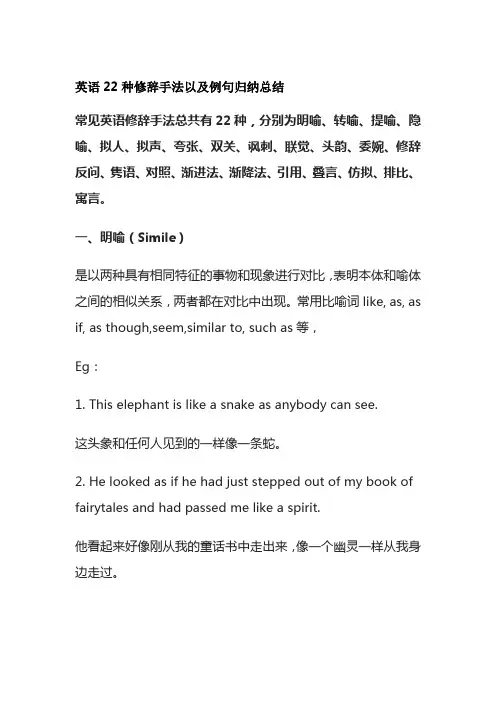
英语22种修辞手法以及例句归纳总结常见英语修辞手法总共有22种,分别为明喻、转喻、提喻、隐喻、拟人、拟声、夸张、双关、讽刺、联觉、头韵、委婉、修辞反问、隽语、对照、渐进法、渐降法、引用、叠言、仿拟、排比、寓言。
一、明喻(Simile)是以两种具有相同特征的事物和现象进行对比,表明本体和喻体之间的相似关系,两者都在对比中出现。
常用比喻词like, as, as if, as though,seem,similar to, such as等,Eg:1. This elephant is like a snake as anybody can see.这头象和任何人见到的一样像一条蛇。
2. He looked as if he had just stepped out of my book of fairytales and had passed me like a spirit.他看起来好像刚从我的童话书中走出来,像一个幽灵一样从我身边走过。
3. It has long leaves that sway in the wind like slim fingers reaching to touch something.它那长长的叶子在风中摆动,好像伸出纤细的手指去触摸什么东西似的。
二、隐喻(Metaphor)这种比喻不通过比喻词进行,而是直接将用事物当作乙事物来描写,甲乙两事物之间的联系和相似之处是暗含的。
Eg:1、The diamond department was the heart and center of the store.钻石部是商店的心脏和核心。
2. He is a pig.他简直是头猪。
(比喻:他是一个像猪一般的人,指肮脏,贪吃的人。
)3. She is a woman with a stony heart.她是一个铁石心肠的女人。
(比喻:这个女人冷酷无情。
)4.Mark Twain is a mirror of America.马克•吐温是美国的一面镜子。
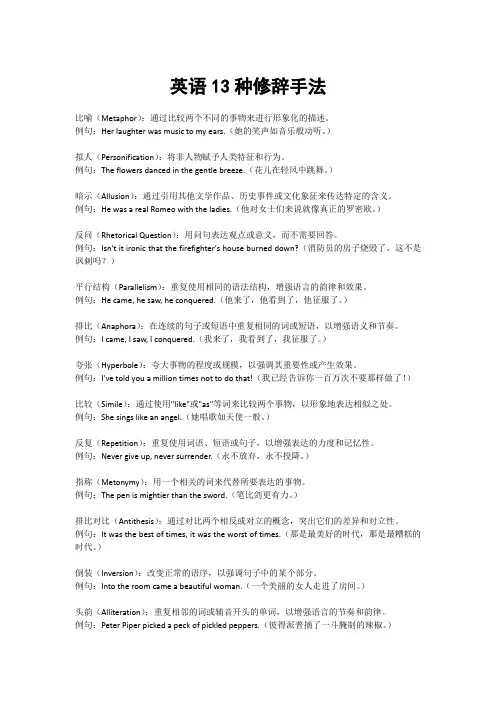
英语13种修辞手法比喻(Metaphor):通过比较两个不同的事物来进行形象化的描述。
例句:Her laughter was music to my ears.(她的笑声如音乐般动听。
)拟人(Personification):将非人物赋予人类特征和行为。
例句:The flowers danced in the gentle breeze.(花儿在轻风中跳舞。
)暗示(Allusion):通过引用其他文学作品、历史事件或文化象征来传达特定的含义。
例句:He was a real Romeo with the ladies.(他对女士们来说就像真正的罗密欧。
)反问(Rhetorical Question):用问句表达观点或意义,而不需要回答。
例句:Isn't it ironic that the firefighter's house burned down?(消防员的房子烧毁了,这不是讽刺吗?)平行结构(Parallelism):重复使用相同的语法结构,增强语言的韵律和效果。
例句:He came, he saw, he conquered.(他来了,他看到了,他征服了。
)排比(Anaphora):在连续的句子或短语中重复相同的词或短语,以增强语义和节奏。
例句:I came, I saw, I conquered.(我来了,我看到了,我征服了。
)夸张(Hyperbole):夸大事物的程度或规模,以强调其重要性或产生效果。
例句:I've told you a million times not to do that!(我已经告诉你一百万次不要那样做了!)比较(Simile):通过使用"like"或"as"等词来比较两个事物,以形象地表达相似之处。
例句:She sings like an angel.(她唱歌如天使一般。
)反复(Repetition):重复使用词语、短语或句子,以增强表达的力度和记忆性。
英文中的修辞手法英文中有许多修辞手法,这些手法通过运用特定的语言技巧,可以增强文学作品的表达力和感染力。
以下是一些常见的英文修辞手法:比喻(Metaphor):将两个不同的事物进行比较,以强调它们之间的相似之处,而不使用"like"或"as"。
例如:“时间是一把无情的剑。
”拟人(Personification):赋予非人物以人的特质或行为,使其更具生动性。
例如:“风儿轻轻地低语。
”象征(Symbolism):使用一个事物、符号或象征来代表另一个抽象概念。
例如:“燕子在文学中通常象征着春天和希望。
”暗喻(Metonymy):用一个与所指实体有着密切关联的词汇来替代它。
例如:“白宫发布了一份声明”中的“白宫”代表美国政府。
排比(Parallelism):通过使用相似的句式或结构,强调语言的平衡和韵律。
例如:“我不怕困难,我不怕失败,我不怕挑战。
”双关语(Pun):利用一个词汇项的多义性或相似的发音来制造幽默或引起思考。
例如:“时间飞逝,果然很‘秒’。
”讽刺(Irony):通过言辞上的反讽,表达与字面意义相反的意思。
例如:“这个‘伟大’的计划居然失败了。
”悬念(Suspense):通过保持某种信息的不明确,刺激读者的兴趣,以激发紧张感。
例如:“她打开门,里面的一切都让她惊呆了。
”对仗(Antithesis):将相对或对立的思想或概念通过并列的结构进行强调。
例如:“昨夜寒风凛冽,今朝暖阳明媚。
”比较(Simile):将两个事物通过使用"like"或"as"进行比较,以突显它们之间的相似之处。
例如:“她如同一朵盛开的花。
”这些修辞手法可以单独使用,也可以结合在一起,创造出更为复杂和富有表现力的文学效果。
作家通常根据他们的写作目的,选择最适合表达自己意图的修辞手法。
英语写作中的修辞知识归纳英语写作中的修辞知识归纳学英语写作中的修辞修辞手段一般主要用于文学性写作中。
但在大学英语的英文写作中有时也需要运用一定的具有英文特征的修辞手段,而且运用得好,会使语句生动从而增添语句亮点。
因此,掌握一些一般常用修辞手段对于实现语句亮点也是非常必要的。
对于大学英语写作来说,主要应该掌握以下修辞手段,又称语句辞格,包括结构辞格与语义辞格。
对比、排比、重复、倒装等为结构辞格,转义、双关、矛盾等则为语义辞格。
1、对比正反对比就是要巧妙地运用对称的英文句式来表达互为补充的意思,因此恰当地运用反义词语往往是必不可少的。
如果一旦所要表达的内容具有这种情况,就应尽力选用这种对称的句式并选用适当的反义词语来加强语句,实现语句的亮点。
1)如“很多人很快就会发现,他们在物质上是富裕了,精神上却很贫乏”,可以这样达:Many people will soon find themselves rich in goods, but ragged in spirit.(注:句中rich in 与 ragged in, goods 与 spirit 具有正反对比的关系和效果。
)2)如“利远远大于弊”,可以这样表达:The advantages for outweigh the disadvantages.(注:句中 the advantages 与 the disadvantages 具有正反对比的关系和效果。
)3)如“他们注意到了这些说法中的一些道理,但他们却忽视了一个重要的事实”,可以这样表达:They have noticed a grain of truth in the statements, but have ignored a more important fact.(注:句中have noticed 与 have ignored, a grain of truth in the statements 与 a more important fact 具有正反对比的关系和效果。
大学英语教材中常见的英语修辞摘要:英语修辞在大学英语教材中是一项重要的内容。
因为有些修辞用法相似,所以很难区别。
现以大学英语教材中常见的四种修辞为例并介绍它们的特征以及如何区分。
关键词:英语修辞;明喻;暗喻;拟人;委婉语1 明喻(simile)明喻是表现一事物像另一事物的修辞格。
说得通俗点,也就是打比方,即把要描述的事物——本体(A)用比喻词与另一种具有鲜明的同一特征的事物——喻体(B)联系起来。
常用的比喻词有 as(如), like(像), seem(似乎), as if(好像), as though(好像), such as(像……一样)等。
其基本格式是"A is like B"或"A is as…as B"。
例如:(1)Her eyes were blue as flowers,and in her pale green suit she was like springtime come alive.她的眼睛碧蓝,如花似玉。
她身穿浅绿色套装,犹如春天一般生机盎然。
(Unit 5 Text A,New College English 1)课文中作者把霍利思·梅奈尔小姐的青春活力和春天万物欣欣向荣联系起来。
(2)Records fell like ripe apples on a windy day.(E.B.White)被打破的记录犹如刮风天成熟的苹果——纷纷坠落。
(3)We feel as if we've been faxed.(Unit 7 Text A,New College English 4)太热了,我们觉得自己被传真过似的。
请注意下面这句话:Jim looks like his brother Billy.吉姆和他的兄弟比利长得很像。
这句话就不是明喻:这里把两件相同的事物(两个人)做比较。
2 暗喻(metaphor)这种比喻不通过比喻词进行,而是直接将甲事物当作乙事物来描写,甲乙两事物之间的联系和相似之处是暗含的。
大学英语中常见的修辞手法1 明喻(Simile)明喻是一种最简单、最常见的修辞方法,是以两种具有共同特征的事物或现象进行对比,表明本体和喻体的关系,两者都在对比中出现,其基本格式是“A像B”,常用的比喻词有as, like, as if, as though等。
如果使用得当可以把深奥的道理说得通俗、浅显、明白,使人可见可感可悟,把简单的事物表达的更为形象更为生动。
例如:Like climbing a mountain, we struggle up three feet and fall back two.(正如爬山,我们费力爬上三英尺,又掉下去两英尺。
)(大学英语第一册第三单元课文B)I see also the dull, drilled, docile, brutish masses of the Hun soldiery blodding on like a swarm of crawling locusts.(丘吉尔在此使用了一个恰当的比喻,把德国士兵比作蝗虫,因为二者有着共同之处-传播毁灭。
)2 暗喻(the metaphor)暗喻也是一种比喻,但不用比喻词,因此被称作缩减了的明喻(a compressed simile)。
它是根据两个事物间的某些共同的特征,用一事物去暗示另一事物的比喻方式。
本体和喻体之间不用比喻词,只是在暗中打比方,从而更生动、更深刻地说明事理,增强语言的表现力。
例如:I will do anything I can to help him through life's dangerous sea.(我将全力帮助他穿越人生的惊涛骇浪。
)(第二册第三单元课文A)Consider that the same cultural soil producing the English language also nourished the great principles of freedom and right of man in the modern world.(想想吧,孕育英语的文化土壤也同样为当今世界培育了自由和人权准则。
1.Simile 明喻明喻是将具有共性的不同事物作对比.这种共性存在于人们的心里,而不是事物的自然属性.标志词常用like, as, seem, as if, as though, similar to, such as等.例如:1>.He was like a cock who thought the sun had risen to hear him crow.2>.I wandered lonely as a cloud.3>.Einstein only had a blanket on, as if he had just walked out of a fairy tale.2.Metaphor 隐喻,暗喻隐喻是简缩了的明喻,是将某一事物的名称用于另一事物,通过比较形成.例如:1>.Hope is a good breakfast, but it is a bad supper.2>.Some books are to be tasted, others swallowed, and some few to be chewed and digested.3.Metonymy 借喻,转喻借喻不直接说出所要说的事物,而使用另一个与之相关的事物名称.I.以容器代替内容,例如:1>.The kettle boils. 水开了.2>.The room sat silent. 全屋人安静地坐着.II.以资料.工具代替事物的名称,例如:Lend me your ears, please. 请听我说.III.以作者代替作品,例如:a complete Shakespeare 莎士比亚全集VI.以具体事物代替抽象概念,例如:I had the muscle, and they made money out of it. 我有力气,他们就用我的力气赚钱.4.Synecdoche 提喻提喻用部分代替全体,或用全体代替部分,或特殊代替一般.例如:1>.There are about 100 hands working in his factory.(部分代整体)他的厂里约有100名工人.2>.He is the Newton of this century.(特殊代一般)他是本世纪的牛顿.3>.The fox goes very well with your cap.(整体代部分)这狐皮围脖与你的帽子很相配.5.Synaesthesia 通感,联觉,移觉这种修辞法是以视.听.触.嗅.味等感觉直接描写事物.通感就是把不同感官的感觉沟通起来,借联想引起感觉转移,“以感觉写感觉”。
以下是英语中常见的30种修辞手法:Alliteration(头韵): 一组词以相同的辅音音素开头。
Assonance(音韵): 一组词以相似的元音音素结尾或出现在词中。
Consonance(谐音): 一组词以相似的辅音音素结尾或出现在词中。
Simile(明喻): 使用"like"或"as"来进行比较,以明确两个不同的事物之间的相似之处。
Metaphor(隐喻): 通过将一个事物或概念直接应用于另一个事物或概念来进行比喻。
Personification(拟人): 赋予非人类事物或抽象概念人类的特征和行为。
Hyperbole(夸张法): 通过夸大和放大来强调一个观点或形容事物。
Understatement(轻描淡写法): 通过故意低估事物的重要性或程度来强调其效果。
Irony(讽刺): 通过语言表达与实际意义相反或冲突的观点。
Paradox(矛盾): 使用自相矛盾的语句来引起读者的思考和注意。
Oxymoron(矛盾修辞法): 将两个相反的词或短语并列使用,形成矛盾的修辞效果。
Euphemism(委婉语): 使用较为委婉的措辞来替代直接或冒犯性的表达。
Repetition(重复): 在文章或诗歌中重复使用相同的词语或短语来强调观点。
Parallelism(排比): 使用类似的语法结构或句式来强调一组观点。
Antithesis(对偶): 在句子或短语中对立地表达两个相反的观点或概念。
Climax(递进): 通过递进的方式将观点或事件按照重要性或程度进行排列。
Juxtaposition(并列): 将两个不同的事物或观点放置在一起,以产生对比或突出效果。
Anaphora(回文): 在连续的句子或短语中重复使用相同的词语或短语。
Epiphora(尾韵): 在句子或短语的结尾重复使用相同的词语或短语。
Allusion(典故): 引用文学、历史或文化中的人物、事件或作品来传达观点或增加文采。
篇一:大学英语修辞手法总结英语修辞手法总结4)personification/p??s?n?f??ken/: (拟人)it gives human form of feelings to animals, or life and personal attributes(赋予) to inanimate(无生命的) objects, or to ideas and abstractions(抽象). for example, the wind whistled through the trees.5) hyperbole/ha?ˋp?b?l?/: (夸张) it is the deliberate use of overstatement or exaggeration to achieve emphasis. for instance, he almost died laughing.6) understatement: (含蓄陈述) it is the opposite of hyperbole, or overstatement. it achieves its effect of emphasizing a fact by deliberately(故意地) understating it, impressing the listener or the reader more by what is merely implied or left unsaid than by bare statement. for instance, it is no laughing matter.7)euphemism/ ?ju?f?m?z?m/: (委婉) it is the substitution of an agreeable orinoffensive(无冒犯) expression for one that may offend or suggest something unpleasant. for instance, we refer to die as pass away.8) metonymy (转喻)it is a figure of speech that has to do with the substitution of the mane of one thing for that of another. for instance, the pen (words) is mightier than the sword (forces).9)synecdoche[sinekd?ki] (提喻) it is involves the substitution of the part for the whole, or the 2whole for the part. for instance, they say theres bread and work for all. she was dressed in silks.10)antonomasia[??nt?nouˋm?i??](换喻)it has also to do with substitution. it is not oftenmentioned now, though it is still in frequent use. for example, solomon for a wise man. daniel for a wise and fair judge. judas for a traitor.11) pun: (双关语)it is a play on words, or rather a play on the form and meaning of words. for instance, a cannon-ball took off his legs, so he laid down his arms. (here arms has two meanings:a persons body; weapons carried by a soldier.)12) syllepsis [silepsis]: (一语双叙) it has two connotations.in the first case, it is a figure by which a word, or a particular form or inflection of a word, refers to two or more words in the same sentence, while properly applying to or agreeingwith only on of them in grammar or syntax(句法). for example, he addressed you and me, and desired us to follow him. (here us is used to refer to you and me.)in the second case, it a word may refer to two or more words in the same sentence. for example, while he was fighting , and losing limb and mind, and dying, others stayed behind to pursue education and career. (here to losing ones limbs in literal; to lose ones mind is figurative, and means to go mad.)13)zeugma[zju:gm?]: (轭式搭配) it is a single word which is made to modify or to govern two or more words in the same sentence, wither properly applying in sense to only one of them, or applying to them in different senses. for example, the sun shall not burn you by day, nor the moon by night. (here noon is not strong enough to burn) 14) irony/ ˋa?r?n?/: (反语) it is a figure of speech that achieves emphasis by saying the opposite of what is meant, the intended meaning of the words being the opposite of their usual sense. for instance, we are lucky, what you said makes me feel real good.16) sarcasm: (讽刺) it sarcasm is a strong form of irony. it attacks in a taunting and bitter manner, and its aim is to disparage, ridicule and wound the feelings of the subject attacked. for example, laws are like cobwebs, which may catch small flies, but let wasps break through.17) paradox: (似非而是的隽语) it is a figure of speech consisting of a statement or proposition which on the face of it seems self-contradictory, absurd or contrary to 3established fact or practice, but which on further thinking and study may prove to be true, well-founded, and even to contain a succinct point. for example more haste, less speed.19) antithesis: (对照) it is the deliberate arrangement of contrasting words or ideas in balanced structural forms to achieve emphasis. for example, speech is silver; silence is golden.20) epigram: (警句) it states a simple truth pithily(有利地) and pungently(强烈地). it isusually terse and arouses interest and surprise by its deep insight into certain aspects of human behavior or feeling. for instance, few, save the poor, feel for the poor.21) climax: (渐进)it is derived from the greek word for ladder and implies the progression of thought at a uniform or almost uniform rate of significance or intensity, like the steps ofa ladder ascending evenly. for example, i came, i saw, i conquered.22) anti-climax or bathos: (突降)it is the opposite of climax. it involves stating ones thoughts in a descending order of significance or intensity, from strong to weak, from weightyto light or frivolous. for instance, but thousands die, without or this or that, die, and endow(赋予) a college, or a cat.23) apostrophe:(顿呼) in this figure of speech, a thing, place, idea or person (dead or absent) is addressed as if present, listening and understanding what is being said. for instance, england! awake! awake! awake!24) transferred epithet: (转类形容词) it is a figure of speech where an epithet (anadjective or descriptive phrase) is transferred from the noun it should rightly modify(修饰) to another to which it does not really apply or belong. for instance, i spent sleepless nights on my project.25) alliteration: (头韵) it has to do with the sound rather than the sense of words for effect. it is a device that repeats the same sound at frequent intervals(间隔) and since the sound repeated is usually the initial consonant sound, it is also called front rhyme. for instance, the fair breeze blew, the white foam flew, the furrow followed free.26) onomatopoeia: (拟声) it is a device that uses words which imitate the sounds made by an object (animate or inanimate), or which are associated with or suggestive(提示的) of some action or movement4explanation version1一、什么是修辞格修辞格(figures of speech)是提高语言表达效果的语言艺术。